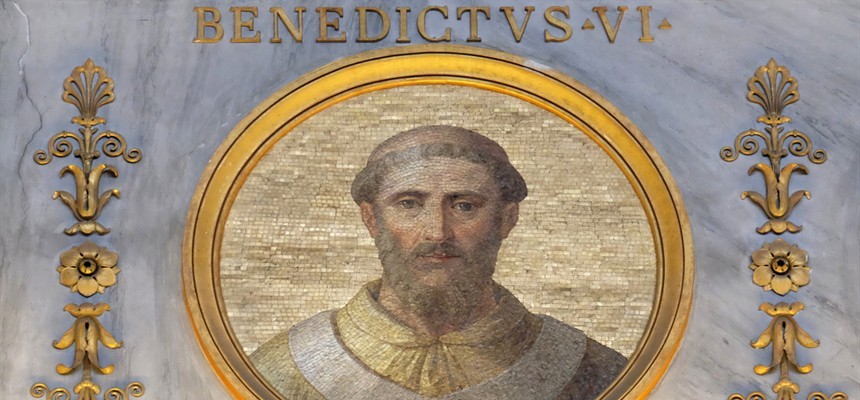
Here is a story of a difficult episode in Church history. Benedict was a Roman, whose father, Hildebrand, was of German descent. In the past 35 years, Otto, the Holy Roman Emperor, a German, had been a controlling factor of the papacy and Italian politics.
Benedict was brought up in Rome and was the cardinal deacon of the church of St. Theodore at the time of the death of Pope John XIII in September 972. The potential electors were split in loyalties between the empire and the Roman nobility. The imperial-backing electors voted for Benedict. The Roman aristocrats (anti-Ottonians) saw Benedict as a puppet for the emperor and resented him. It took three months for the approval to come from Otto before Benedict was consecrated on 19 January, 973.
Not much is known about what Benedict did in his year and a half on the throne. Here is what we do know: He confirmed privileges or they were simply assumed by monasteries and churches. As requested by King Lothair and Queen Emma of France, hi put the monastery of Blandin, France under papal protection. Other actions are questioned as to their authenticity: a papal bull proclaiming Frederick, archbishop of Salzburg and his successors proclaimed papal vicars in Upper and Lower Pannonia and Noricum.
Emperor Otto I died suddenly, at age 60, on 7 May, 973. His co-emperor and heir was his seventeen year old son, Otto II. Otto had just gotten married to a Byzantine princess to promote peace with Byzantium. He also had problems with the German nobility. He was distracted from his interests in Italy.
Once the Roman aristocrats heard about the older emperor’s and the young emperor’s distractions, they made plans to move against the pope. Two people figure very prominently in this scene. One was a man referred to as Crescentius the Elder. He was the brother of Pope John XIII, a politician and organizer. The other was Cardinal Deacon Franco Boniface Ferrucci, the candidate of the anti-Ottonians. In June, 974, Pope Benedict was arrested and imprisoned at the Castel Sant’Angelo, at the time a strong-hold of the Crescentii. Ferrucci was proclaimed Pope Boniface VII by July.
News got to Emperor Otto II as he was fighting in Bavaria. He couldn’t get away to help. So, he sent Count Sicco, as imperial representative, with a demand to release the legal pope, Benedict. Within a short period of time, the count’s army had Rome surrounded. Fearing the worst, Romans panicked, became chaotic and rioted. Boniface VII hid in the Castel Sant’Angelo for a short time. Either Boniface or Crescentius gave orders to a priest named Stephen to kill the true pope. Benedict was strangled in prison. Boniface plundered the Vatican of many of its treasures then managed to escape to southern Italy, which was still in the hands of the Byzantine empire. He eventually made it to Constantinople. It was August, 974.
Benedict was dead. Boniface was in exile. Another election was being set up. But Boniface was not done with Rome.

Recent Comments